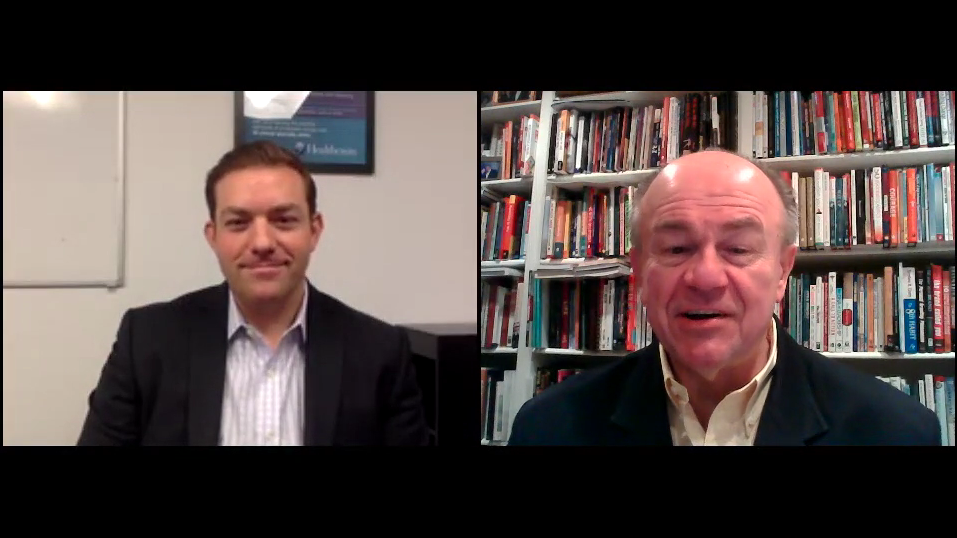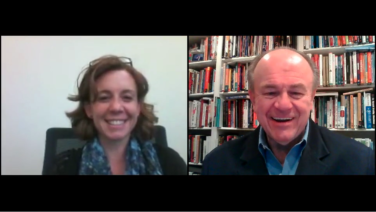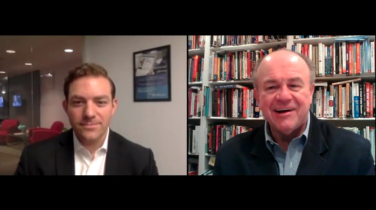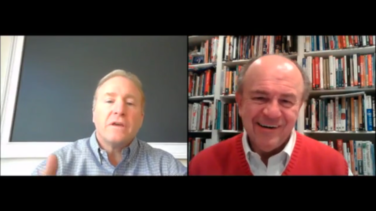You have heard it before. Reps are having an increasingly difficult time getting in to see doctors and even when they do, their time is very limited. Well, Erik Dalton, Executive Vice President at Healthcasts, has a solution. The first step is asking physicians what they want. Don’t waste their time or yours with information they don’t care about—get right to the heart of what each individual physician wants to know. But that is just the beginning. By also enhancing the rep experience with customized digital campaigns—simple banner ads don’t cut it—you can reach a lot more physicians. With just one campaign Healthcasts was able to turn interactions with more than 700 no-see physicians into open opportunities.
Transcript
Bud Bilanich: Hi, everybody. Bud Bilanich, back with another edition of the “Experts on Call” video series. And I want to welcome back Erik Dalton, who is the Executive Vice President of Healthcasts. And we’re going to talk a little bit today about multichannel. So, Erik, welcome back. Thanks again for taking the time to chat with us.
Erik Dalton: Absolutely. Thanks, Bud.
Bud Bilanich: All right. So, it’s no secret that these days reps have a difficult time getting in to see docs. Docs want to see patients and they don’t have as much time as they once had for reps. So, that means that we’re getting into multichannel here. And so, as we get into multichannel, how do we make sure that we get the message across but in such a way that it still has some of the personalized feel to it that you get when a rep is sitting face-to-face with a doc.
Erik Dalton: Sure, yeah. It’s a great question. It’s a complicated one, but I think it’s one that can be solved over a period of time.
I think first we have to look at: Why has the dynamic shifted between going to much more digital-type promotions versus with just being with reps in the field? I think one of the keys there is the value has to really coherently go through that entire process. So, what is a physician and their patients finding value in? So, one of the things that we found is to focus on that value, and then you worry about “How do I get there?” as kind of part two.
So, for us, one of the things in years past, you had a number of reps providing really inherent value in the information that they were providing. Now, that time in which you can provide that information is very limited. So, to a physician, if I have a choice between seeing a patient or gaining some information from the rep that I know I can get elsewhere, I’m probably going to choose the patient. So, what we have to do is focus on: How do we bring more information or how do we enhance that process?
So, there are a number of ways which I can kind of talk about that people in companies such as Healthcasts are working on. But I think we have to first focus on that value. So, one of the ways that you can do that is to really supplement everything that the field force is trying to do in a personalized approach, but doing that in a more online or digital environment, if you will. The key to that is giving the physician the choice. So, in years past you may come up with three or four key points that you want to make sure you touch on in either a personal approach or a digital approach, but the physician may only have time to see one, or may only have an interest in learning about one or two of those topics.
A number of companies are kind of going through a process where to start the engagement with the physician both at a personal level and a digital level they’re actually asking the physicians what they’re interested in first. That’s really the first step in the process. Well, then, a physician is much more inherently wanting to go through that because they feel like they’re given the choice. It feels more like a traditional learning experience, versus “I want to make sure you hear these three points that I want to discuss with you today, and here are what they are.”
Bud Bilanich: So, for a brand manager we’re almost kind of like talking about pull versus push. So, in other words, if you take the time to figure out what the physician wants to hear as opposed to “Boy, we really have a cool way to present this and we’re going to push it at all these physicians,” you’re going to be better off. Is that the basic message I’m hearing you say.
Erik Dalton: Yeah, it is. But it also can foundationally be included as a part of the engagement. So, instead of trying to figure all that behind the scenes, build that into your solution, whether it be at the personal level with the rep. As an example of that, a rep going in and saying, “Here are the three key points I want to talk to you about today” is a different experience to the physician than them going in and saying, “What do you have interest in to learn about today? Okay, great. You want to talk about the mechanism of action. Or the safety. Let me just show you that.” Or, “Hey, if you don’t have time today, why don’t I push that too you separately just on the efficacy, and then later I can follow up to showcase the mechanism of action, the safety, or whatever it may be.”
Bud Bilanich: Well, how do you do that digitally? Because it’s one thing to have the personal experience, you and me sitting across from the doc. It’s a whole other thing to try to get that information from the doc about what he or she wants digitally. So, what are your suggestions for that?
Erik Dalton: Sure. So, we kind of call it the personal journey, if you will. So, you’re really starting off with a foundation of, “Okay, here are the five things that you may want to learn about today.” Or, you can simply start with “What are the”—you know, in a multiple choice way—“What are the key things that you’re interested in regarding this treatment or this disease?” and allowing them to kind of select one or two of those. And then, a journey is built behind the scenes based on a unique algorithm that then provides them with that information. And they either can participate in it right there immediately or they can have it sent to their email and participate in it later. It really is giving them the choice all the way through.
Bud Bilanich: So, it’s kind of like an if-then kind of algorithm? That’s really cool. That’s really cool. And so, what you’re finding is that you can replicate almost this personalized experience digitally?
Erik Dalton: Yeah. We’re not trying to just replicate it. And we’re not trying to replace it. I think that’s the key component of this. For us, what we’ve found is providing inclusive information that actually helps support the reps that are in the field along with a digital process is a really great scenario. So, an example of that is: One of the things, a campaign that we’ve recently worked on is having those materials that are going to be provided to the rep, also providing those digitally on Healthcasts. So, one of the great things as a rep, you can go in and say, “Hey, what information would you like to learn about? Okay, great. You may have time to talk about that today with me. That’s great. Perfect. If you don’t, you can either access this on Healthcasts—I can send it to you.” You know, there’s a connection there. It’s a great scenario to be able to find that experience that’s in the rep field also online. You can promote that scenario.
So, companies are finding a lot of success in doing that and not trying to replace one of those. And brand managers oftentimes are trying to connect those dots, but the campaigns that they’re actually executing are still disconnected: Even though kind of from a 30,000-foot view they’re still connected, they’re not as connected as they possibly could be.
Bud Bilanich: So, one builds on the other. In other words, if you have—the rep is there, he or she can actually send the doc at the doc’s leisure to something on Healthcasts as well as if—just the way you’ve set up your algorithm, docs can—by entering certain kinds of information, can get more personalize information for themselves on Healthcasts too. So, they—
Erik Dalton: So, the value inherently in that is you’re giving the physician the choice.
Bud Bilanich: Yes.
Erik Dalton: And the physician will see that differently versus either Healthcasts or a field rep trying to kind of force information down their throat that they need to be able to get out at that time. Give the physician the choice first and then provide the information.
And also, I think a key for us is: Don’t try to do it all in one shot. You want to do it over multiple touch points over a given period, because a physician is not going to try to learn everything in just one simple take. This takes months and years at a time to keep on those key touch points. But it’s great because you get to follow up with more information.
Bud Bilanich: Well, that’s very interesting, what you’re doing. So, you had mentioned that—about a program that you had worked with one of your clients. Can you give a little more specific example of something that’s worked for you very well?
Erik Dalton: Sure. So, one of the things that we did, we had a client who was about to get FDA approval; it was a big opportunity. So, we were coordinating both disease state awareness before that approval, educating physicians on these types of diseases and treatments and things of that nature, what their patients can expect, all those different types of things.
So, we did kind of an educational video on the key points of that. Right? So, we had—I think it was up to 10,000 physicians that participated in that video. And then, as a follow-up to that program, we actually did another program once the drug was approved. So, this was specific program was “Key points about the drug that you can count on.” Right? What are the key things you need to know about prescribing this information?
And then, in a post-program evaluation, we allowed those physicians to choose whether they wanted more information from the rep. So, there was a multiple choice question of that, and then saying, “Well, what more information do you want?” Well, then we were providing all that information back through those proper channels so that the rep can then follow up and provide that information to the physician. Well, it’s great because the physician is gaining value from that; the pharmaceutical company is using both their digital campaigns as well as their rep campaigns and tying those in directly together.
Bud Bilanich: So, I’m a brand manager and I’m here, sitting here and saying, “That’s great. What kind of results did you get out of that campaign?”
Erik Dalton: Yeah, for sure. So, one of the key things is we saw there were a lot of “no-see” physicians in that perspective. So, you were able to turn those “no-see” interactions—I think we saw over 700 different interactions change from “no-see” physicians that literally did not see reps at all into rep visits that were open opportunities for them.
Bud Bilanich: Seven hundred?
Erik Dalton: In addition to that, we saw as a follow-up campaign email, we saw a 50% open rate for those key indicators, which is really about double what the typical industry average is. So, again, it was all about customizing those campaigns, understanding what physicians really want in that, and then providing them that value.
Bud Bilanich: So, what are the two, three key points that you learned, and also that the brand managers took away from all this?
Erik Dalton: Yeah, I think the key is to really try to understand what the different campaign components are and then figure out: What’s working? What’s not working? And then, how do we customize and build in those solutions so that we’re not trying to replace the rep, we’re not trying to just replicate the rep, we’re trying to enhance the rep experience. So, providing physicians those key values.
I think, then, subsequently to that, is really trying to foundationally understand: How do we move that needle forward in the future? So, how do we now take this campaign and go, “Okay, we’ve built on from a disease awareness perspective. We’ve build on the brand key perspectives. And now, we’ve even built in the sales rep. Okay, what do we do next?” Well, the key to that is to listen to their foundational feedback of that. So, instead of trying to just say, “Well, now we’re going to focus on the efficacy or the safety,” still provide that opportunity for the physician to choose what they want their next experience to be.
Bud Bilanich: Well, it’s very interesting. It kind of reminds me of the old—I’ve been in the consulting business since 1988; it kind of reminds me of the old joke about, “The consultant is somebody who borrows your watch to tell you what time it is.”
Erik Dalton: Yeah.
Bud Bilanich: And in some ways, that’s what you’re doing. You’re basically saying to the physician, “What do you want? And now, we’ll come and tell you what you want.”
Erik Dalton: Yeah. And I think brand managers in particular are becoming much more kind of focused on that fact. I mean, these are individuals who have been out in the field for years, that are constantly going on rep follow-alongs and those things. So, they’re becoming much more kind of open-minded to these types of approaches, and I think they’re having benefit for everybody involved.
Bud Bilanich: Yeah. So, what I really like about what you’re saying here is that this is true multichannel because it’s not just digital channels: You’re putting human beings into the equation too. So, I like what you had said about enhancing the rep interaction with the doc through using digital channels.
Erik Dalton: Exactly. And we’ve found that—we don’t do kind of the traditional banner ads and things of that nature. We really want to have customized campaigns that really help move the needle but also, again, provide value to everybody involved.
Bud Bilanich: And so, I mean, that’s a way—probably a good way to wrap it up, that if you’re a brand manager and you’re thinking about this, the more you can involve the physician in giving you information about what he or she really wants and needs, probably the more effective you’re going to be with your campaigns, both with your reps in person as well as what you’re doing digitally.
Erik Dalton: Absolutely.
Bud Bilanich: All right. That’s great, Erik. Thank you so much again. I mean, it’s always such a pleasure to speak with you. And again, folks, check out the Healthcasts and what they have to offer. And again, Erik, Executive VP—nice title—of Healthcasts, thanks so much for chatting with us today.
Erik Dalton: Great. Thanks, Bud. I really appreciate it.




